Professional Development: Coaching Session Assessment - Written Test
VerifiedAdded on 2023/01/11
|30
|7748
|46
Homework Assignment
AI Summary
This document is a written assessment on coaching techniques and professional development. The assessment requires the student to answer questions related to various aspects of coaching, including communication strategies, addressing performance problems, and ensuring skill application. It covers topics such as overcoming communication breakdowns, managing inappropriate coaching circumstances, and dealing with language or cultural barriers. The assessment also emphasizes the importance of providing opportunities for practice and feedback to ensure that colleagues can effectively apply the learned skills. Additionally, it explores advantages and disadvantages of different training methods, and the importance of breaking down coaching sessions into smaller chunks. The assessment also includes scenarios and examples to demonstrate the student's understanding of key coaching principles.
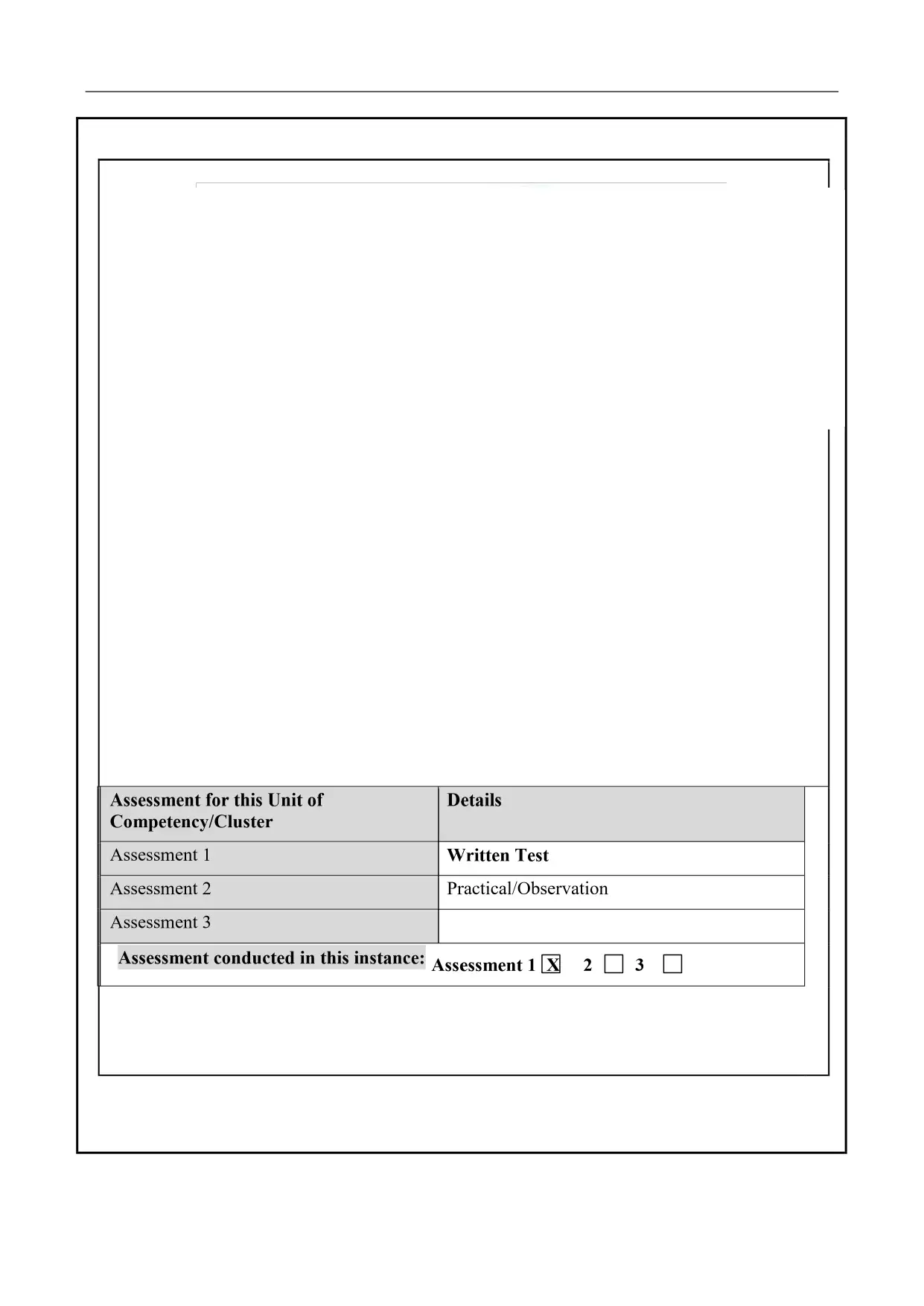
Paraphrase This Document
Need a fresh take? Get an instant paraphrase of this document with our AI Paraphraser
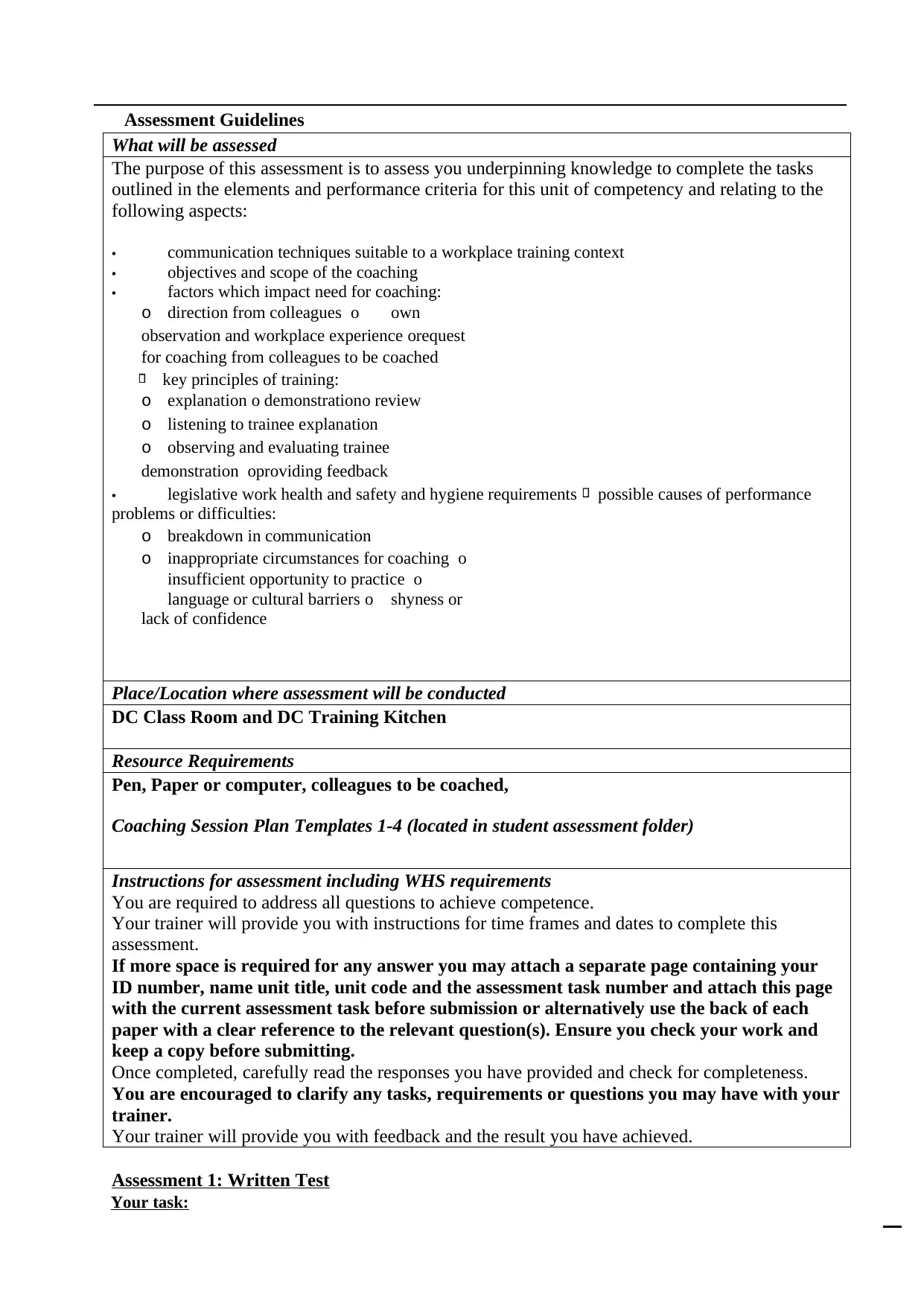
Assessment Guidelines
What will be assessed
The purpose of this assessment is to assess you underpinning knowledge to complete the tasks
outlined in the elements and performance criteria for this unit of competency and relating to the
following aspects:
• communication techniques suitable to a workplace training context
• objectives and scope of the coaching
• factors which impact need for coaching:
o direction from colleagues o own
observation and workplace experience orequest
for coaching from colleagues to be coached
key principles of training:
o explanation o demonstrationo review
o listening to trainee explanation
o observing and evaluating trainee
demonstration oproviding feedback
• legislative work health and safety and hygiene requirements possible causes of performance
problems or difficulties:
o breakdown in communication
o inappropriate circumstances for coaching o
insufficient opportunity to practice o
language or cultural barriers o shyness or
lack of confidence
Place/Location where assessment will be conducted
DC Class Room and DC Training Kitchen
Resource Requirements
Pen, Paper or computer, colleagues to be coached,
Coaching Session Plan Templates 1-4 (located in student assessment folder)
Instructions for assessment including WHS requirements
You are required to address all questions to achieve competence.
Your trainer will provide you with instructions for time frames and dates to complete this
assessment.
If more space is required for any answer you may attach a separate page containing your
ID number, name unit title, unit code and the assessment task number and attach this page
with the current assessment task before submission or alternatively use the back of each
paper with a clear reference to the relevant question(s). Ensure you check your work and
keep a copy before submitting.
Once completed, carefully read the responses you have provided and check for completeness.
You are encouraged to clarify any tasks, requirements or questions you may have with your
trainer.
Your trainer will provide you with feedback and the result you have achieved.
Assessment 1: Written Test
Your task:
What will be assessed
The purpose of this assessment is to assess you underpinning knowledge to complete the tasks
outlined in the elements and performance criteria for this unit of competency and relating to the
following aspects:
• communication techniques suitable to a workplace training context
• objectives and scope of the coaching
• factors which impact need for coaching:
o direction from colleagues o own
observation and workplace experience orequest
for coaching from colleagues to be coached
key principles of training:
o explanation o demonstrationo review
o listening to trainee explanation
o observing and evaluating trainee
demonstration oproviding feedback
• legislative work health and safety and hygiene requirements possible causes of performance
problems or difficulties:
o breakdown in communication
o inappropriate circumstances for coaching o
insufficient opportunity to practice o
language or cultural barriers o shyness or
lack of confidence
Place/Location where assessment will be conducted
DC Class Room and DC Training Kitchen
Resource Requirements
Pen, Paper or computer, colleagues to be coached,
Coaching Session Plan Templates 1-4 (located in student assessment folder)
Instructions for assessment including WHS requirements
You are required to address all questions to achieve competence.
Your trainer will provide you with instructions for time frames and dates to complete this
assessment.
If more space is required for any answer you may attach a separate page containing your
ID number, name unit title, unit code and the assessment task number and attach this page
with the current assessment task before submission or alternatively use the back of each
paper with a clear reference to the relevant question(s). Ensure you check your work and
keep a copy before submitting.
Once completed, carefully read the responses you have provided and check for completeness.
You are encouraged to clarify any tasks, requirements or questions you may have with your
trainer.
Your trainer will provide you with feedback and the result you have achieved.
Assessment 1: Written Test
Your task:
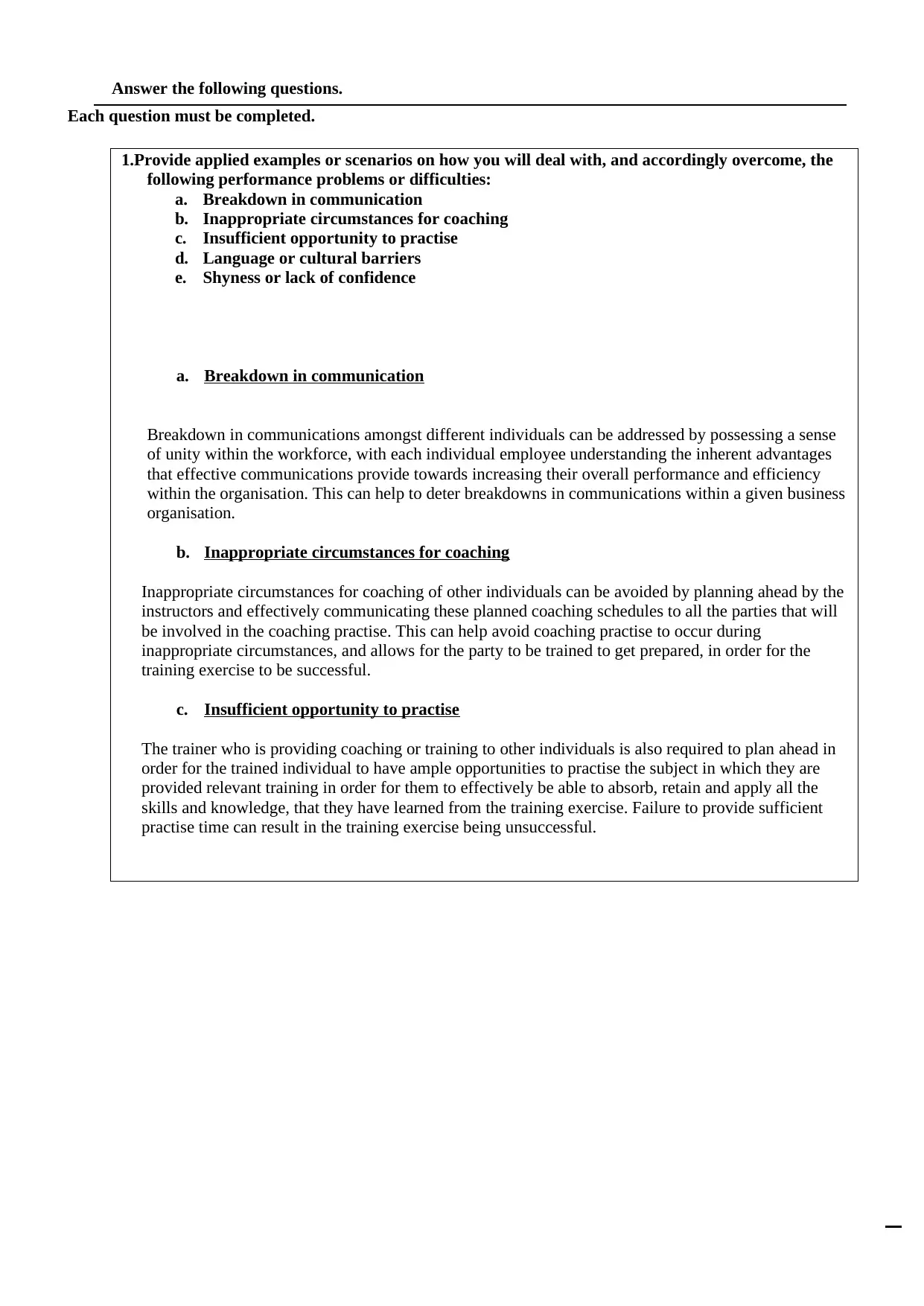
Answer the following questions.
Each question must be completed.
1.Provide applied examples or scenarios on how you will deal with, and accordingly overcome, the
following performance problems or difficulties:
a. Breakdown in communication
b. Inappropriate circumstances for coaching
c. Insufficient opportunity to practise
d. Language or cultural barriers
e. Shyness or lack of confidence
a. Breakdown in communication
Breakdown in communications amongst different individuals can be addressed by possessing a sense
of unity within the workforce, with each individual employee understanding the inherent advantages
that effective communications provide towards increasing their overall performance and efficiency
within the organisation. This can help to deter breakdowns in communications within a given business
organisation.
b. Inappropriate circumstances for coaching
Inappropriate circumstances for coaching of other individuals can be avoided by planning ahead by the
instructors and effectively communicating these planned coaching schedules to all the parties that will
be involved in the coaching practise. This can help avoid coaching practise to occur during
inappropriate circumstances, and allows for the party to be trained to get prepared, in order for the
training exercise to be successful.
c. Insufficient opportunity to practise
The trainer who is providing coaching or training to other individuals is also required to plan ahead in
order for the trained individual to have ample opportunities to practise the subject in which they are
provided relevant training in order for them to effectively be able to absorb, retain and apply all the
skills and knowledge, that they have learned from the training exercise. Failure to provide sufficient
practise time can result in the training exercise being unsuccessful.
Each question must be completed.
1.Provide applied examples or scenarios on how you will deal with, and accordingly overcome, the
following performance problems or difficulties:
a. Breakdown in communication
b. Inappropriate circumstances for coaching
c. Insufficient opportunity to practise
d. Language or cultural barriers
e. Shyness or lack of confidence
a. Breakdown in communication
Breakdown in communications amongst different individuals can be addressed by possessing a sense
of unity within the workforce, with each individual employee understanding the inherent advantages
that effective communications provide towards increasing their overall performance and efficiency
within the organisation. This can help to deter breakdowns in communications within a given business
organisation.
b. Inappropriate circumstances for coaching
Inappropriate circumstances for coaching of other individuals can be avoided by planning ahead by the
instructors and effectively communicating these planned coaching schedules to all the parties that will
be involved in the coaching practise. This can help avoid coaching practise to occur during
inappropriate circumstances, and allows for the party to be trained to get prepared, in order for the
training exercise to be successful.
c. Insufficient opportunity to practise
The trainer who is providing coaching or training to other individuals is also required to plan ahead in
order for the trained individual to have ample opportunities to practise the subject in which they are
provided relevant training in order for them to effectively be able to absorb, retain and apply all the
skills and knowledge, that they have learned from the training exercise. Failure to provide sufficient
practise time can result in the training exercise being unsuccessful.
⊘ This is a preview!⊘
Do you want full access?
Subscribe today to unlock all pages.

Trusted by 1+ million students worldwide
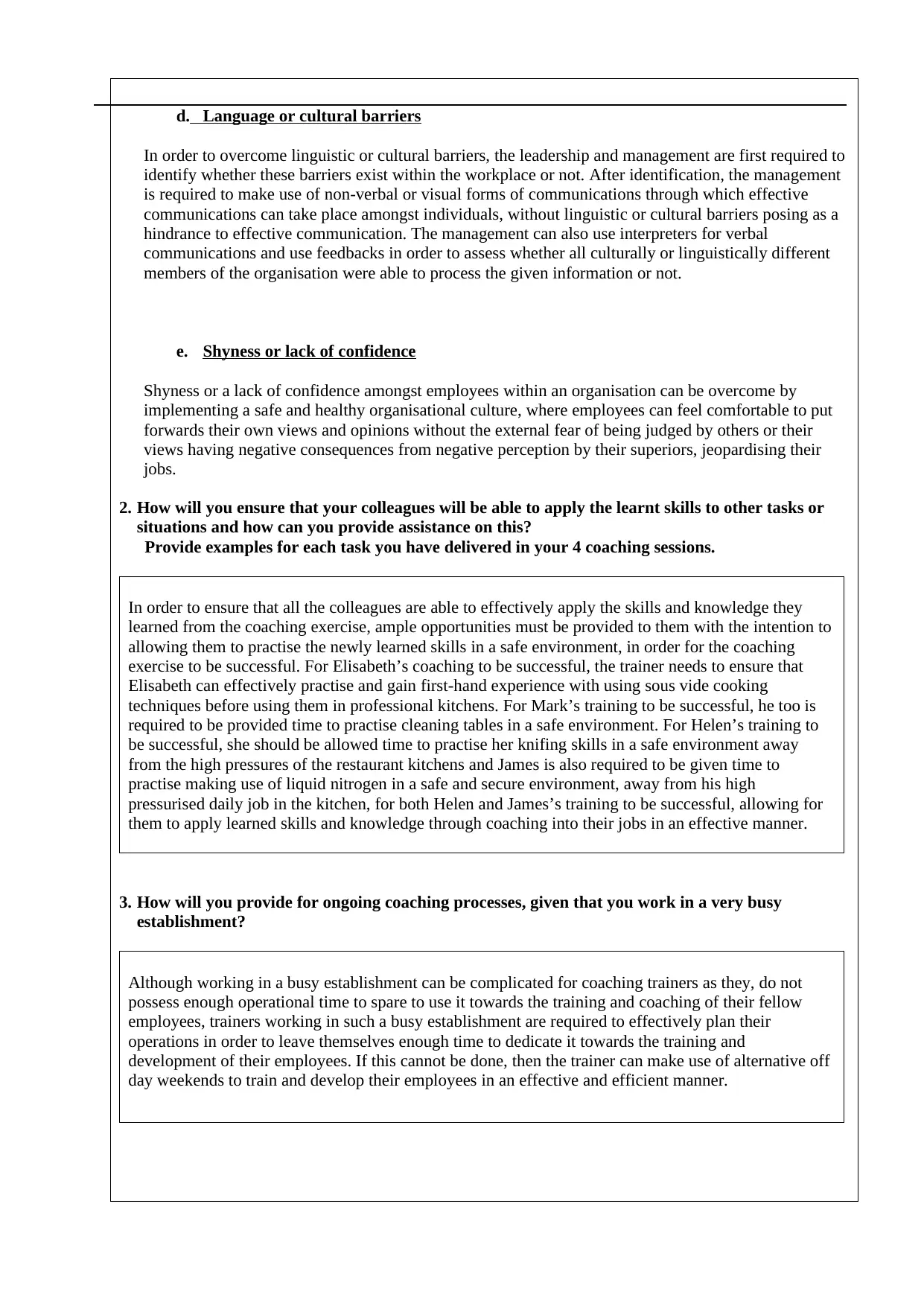
d. Language or cultural barriers
In order to overcome linguistic or cultural barriers, the leadership and management are first required to
identify whether these barriers exist within the workplace or not. After identification, the management
is required to make use of non-verbal or visual forms of communications through which effective
communications can take place amongst individuals, without linguistic or cultural barriers posing as a
hindrance to effective communication. The management can also use interpreters for verbal
communications and use feedbacks in order to assess whether all culturally or linguistically different
members of the organisation were able to process the given information or not.
e. Shyness or lack of confidence
Shyness or a lack of confidence amongst employees within an organisation can be overcome by
implementing a safe and healthy organisational culture, where employees can feel comfortable to put
forwards their own views and opinions without the external fear of being judged by others or their
views having negative consequences from negative perception by their superiors, jeopardising their
jobs.
2. How will you ensure that your colleagues will be able to apply the learnt skills to other tasks or
situations and how can you provide assistance on this?
Provide examples for each task you have delivered in your 4 coaching sessions.
In order to ensure that all the colleagues are able to effectively apply the skills and knowledge they
learned from the coaching exercise, ample opportunities must be provided to them with the intention to
allowing them to practise the newly learned skills in a safe environment, in order for the coaching
exercise to be successful. For Elisabeth’s coaching to be successful, the trainer needs to ensure that
Elisabeth can effectively practise and gain first-hand experience with using sous vide cooking
techniques before using them in professional kitchens. For Mark’s training to be successful, he too is
required to be provided time to practise cleaning tables in a safe environment. For Helen’s training to
be successful, she should be allowed time to practise her knifing skills in a safe environment away
from the high pressures of the restaurant kitchens and James is also required to be given time to
practise making use of liquid nitrogen in a safe and secure environment, away from his high
pressurised daily job in the kitchen, for both Helen and James’s training to be successful, allowing for
them to apply learned skills and knowledge through coaching into their jobs in an effective manner.
3. How will you provide for ongoing coaching processes, given that you work in a very busy
establishment?
Although working in a busy establishment can be complicated for coaching trainers as they, do not
possess enough operational time to spare to use it towards the training and coaching of their fellow
employees, trainers working in such a busy establishment are required to effectively plan their
operations in order to leave themselves enough time to dedicate it towards the training and
development of their employees. If this cannot be done, then the trainer can make use of alternative off
day weekends to train and develop their employees in an effective and efficient manner.
In order to overcome linguistic or cultural barriers, the leadership and management are first required to
identify whether these barriers exist within the workplace or not. After identification, the management
is required to make use of non-verbal or visual forms of communications through which effective
communications can take place amongst individuals, without linguistic or cultural barriers posing as a
hindrance to effective communication. The management can also use interpreters for verbal
communications and use feedbacks in order to assess whether all culturally or linguistically different
members of the organisation were able to process the given information or not.
e. Shyness or lack of confidence
Shyness or a lack of confidence amongst employees within an organisation can be overcome by
implementing a safe and healthy organisational culture, where employees can feel comfortable to put
forwards their own views and opinions without the external fear of being judged by others or their
views having negative consequences from negative perception by their superiors, jeopardising their
jobs.
2. How will you ensure that your colleagues will be able to apply the learnt skills to other tasks or
situations and how can you provide assistance on this?
Provide examples for each task you have delivered in your 4 coaching sessions.
In order to ensure that all the colleagues are able to effectively apply the skills and knowledge they
learned from the coaching exercise, ample opportunities must be provided to them with the intention to
allowing them to practise the newly learned skills in a safe environment, in order for the coaching
exercise to be successful. For Elisabeth’s coaching to be successful, the trainer needs to ensure that
Elisabeth can effectively practise and gain first-hand experience with using sous vide cooking
techniques before using them in professional kitchens. For Mark’s training to be successful, he too is
required to be provided time to practise cleaning tables in a safe environment. For Helen’s training to
be successful, she should be allowed time to practise her knifing skills in a safe environment away
from the high pressures of the restaurant kitchens and James is also required to be given time to
practise making use of liquid nitrogen in a safe and secure environment, away from his high
pressurised daily job in the kitchen, for both Helen and James’s training to be successful, allowing for
them to apply learned skills and knowledge through coaching into their jobs in an effective manner.
3. How will you provide for ongoing coaching processes, given that you work in a very busy
establishment?
Although working in a busy establishment can be complicated for coaching trainers as they, do not
possess enough operational time to spare to use it towards the training and coaching of their fellow
employees, trainers working in such a busy establishment are required to effectively plan their
operations in order to leave themselves enough time to dedicate it towards the training and
development of their employees. If this cannot be done, then the trainer can make use of alternative off
day weekends to train and develop their employees in an effective and efficient manner.
Paraphrase This Document
Need a fresh take? Get an instant paraphrase of this document with our AI Paraphraser
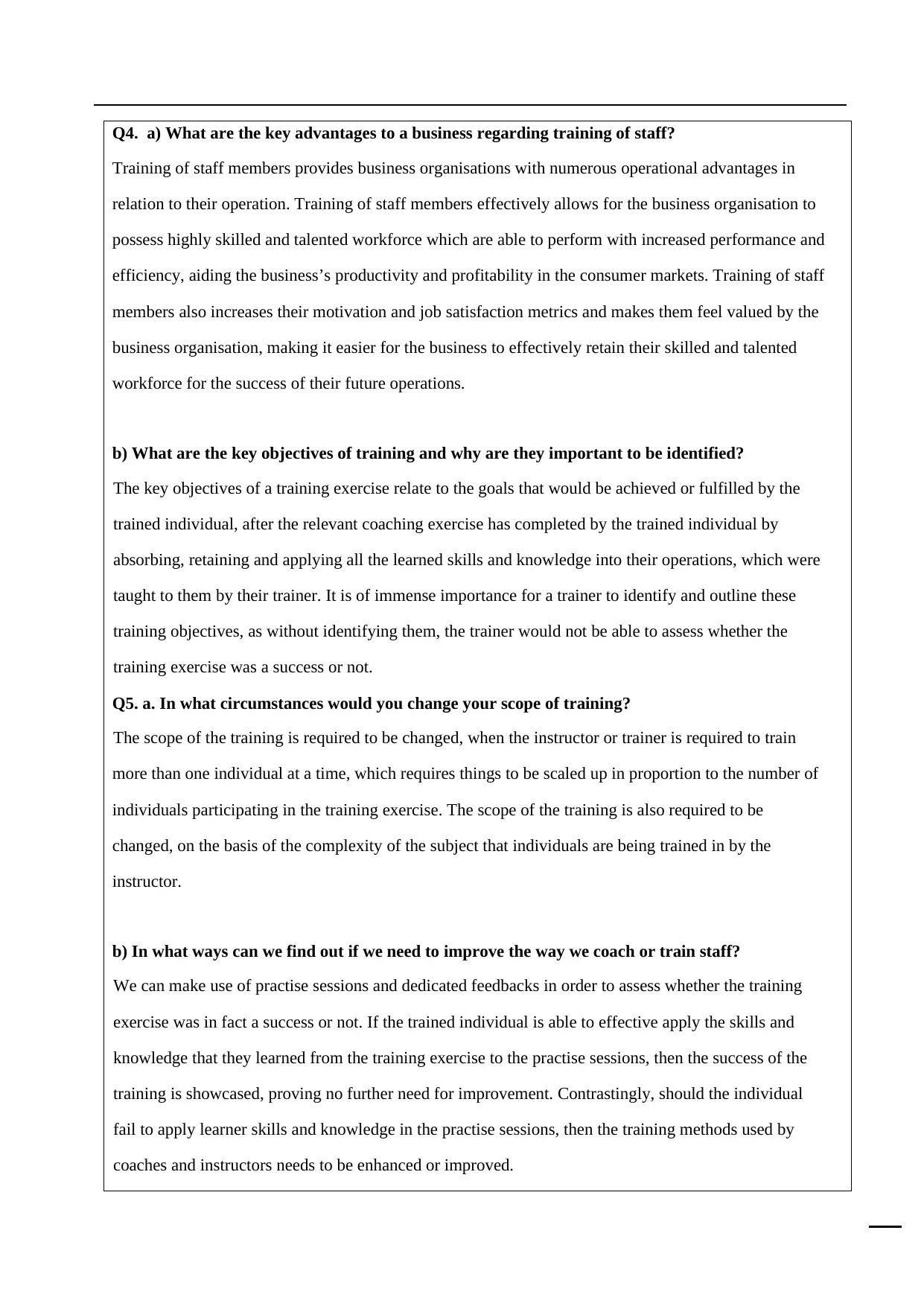
Q4. a) What are the key advantages to a business regarding training of staff?
Training of staff members provides business organisations with numerous operational advantages in
relation to their operation. Training of staff members effectively allows for the business organisation to
possess highly skilled and talented workforce which are able to perform with increased performance and
efficiency, aiding the business’s productivity and profitability in the consumer markets. Training of staff
members also increases their motivation and job satisfaction metrics and makes them feel valued by the
business organisation, making it easier for the business to effectively retain their skilled and talented
workforce for the success of their future operations.
b) What are the key objectives of training and why are they important to be identified?
The key objectives of a training exercise relate to the goals that would be achieved or fulfilled by the
trained individual, after the relevant coaching exercise has completed by the trained individual by
absorbing, retaining and applying all the learned skills and knowledge into their operations, which were
taught to them by their trainer. It is of immense importance for a trainer to identify and outline these
training objectives, as without identifying them, the trainer would not be able to assess whether the
training exercise was a success or not.
Q5. a. In what circumstances would you change your scope of training?
The scope of the training is required to be changed, when the instructor or trainer is required to train
more than one individual at a time, which requires things to be scaled up in proportion to the number of
individuals participating in the training exercise. The scope of the training is also required to be
changed, on the basis of the complexity of the subject that individuals are being trained in by the
instructor.
b) In what ways can we find out if we need to improve the way we coach or train staff?
We can make use of practise sessions and dedicated feedbacks in order to assess whether the training
exercise was in fact a success or not. If the trained individual is able to effective apply the skills and
knowledge that they learned from the training exercise to the practise sessions, then the success of the
training is showcased, proving no further need for improvement. Contrastingly, should the individual
fail to apply learner skills and knowledge in the practise sessions, then the training methods used by
coaches and instructors needs to be enhanced or improved.
Training of staff members provides business organisations with numerous operational advantages in
relation to their operation. Training of staff members effectively allows for the business organisation to
possess highly skilled and talented workforce which are able to perform with increased performance and
efficiency, aiding the business’s productivity and profitability in the consumer markets. Training of staff
members also increases their motivation and job satisfaction metrics and makes them feel valued by the
business organisation, making it easier for the business to effectively retain their skilled and talented
workforce for the success of their future operations.
b) What are the key objectives of training and why are they important to be identified?
The key objectives of a training exercise relate to the goals that would be achieved or fulfilled by the
trained individual, after the relevant coaching exercise has completed by the trained individual by
absorbing, retaining and applying all the learned skills and knowledge into their operations, which were
taught to them by their trainer. It is of immense importance for a trainer to identify and outline these
training objectives, as without identifying them, the trainer would not be able to assess whether the
training exercise was a success or not.
Q5. a. In what circumstances would you change your scope of training?
The scope of the training is required to be changed, when the instructor or trainer is required to train
more than one individual at a time, which requires things to be scaled up in proportion to the number of
individuals participating in the training exercise. The scope of the training is also required to be
changed, on the basis of the complexity of the subject that individuals are being trained in by the
instructor.
b) In what ways can we find out if we need to improve the way we coach or train staff?
We can make use of practise sessions and dedicated feedbacks in order to assess whether the training
exercise was in fact a success or not. If the trained individual is able to effective apply the skills and
knowledge that they learned from the training exercise to the practise sessions, then the success of the
training is showcased, proving no further need for improvement. Contrastingly, should the individual
fail to apply learner skills and knowledge in the practise sessions, then the training methods used by
coaches and instructors needs to be enhanced or improved.
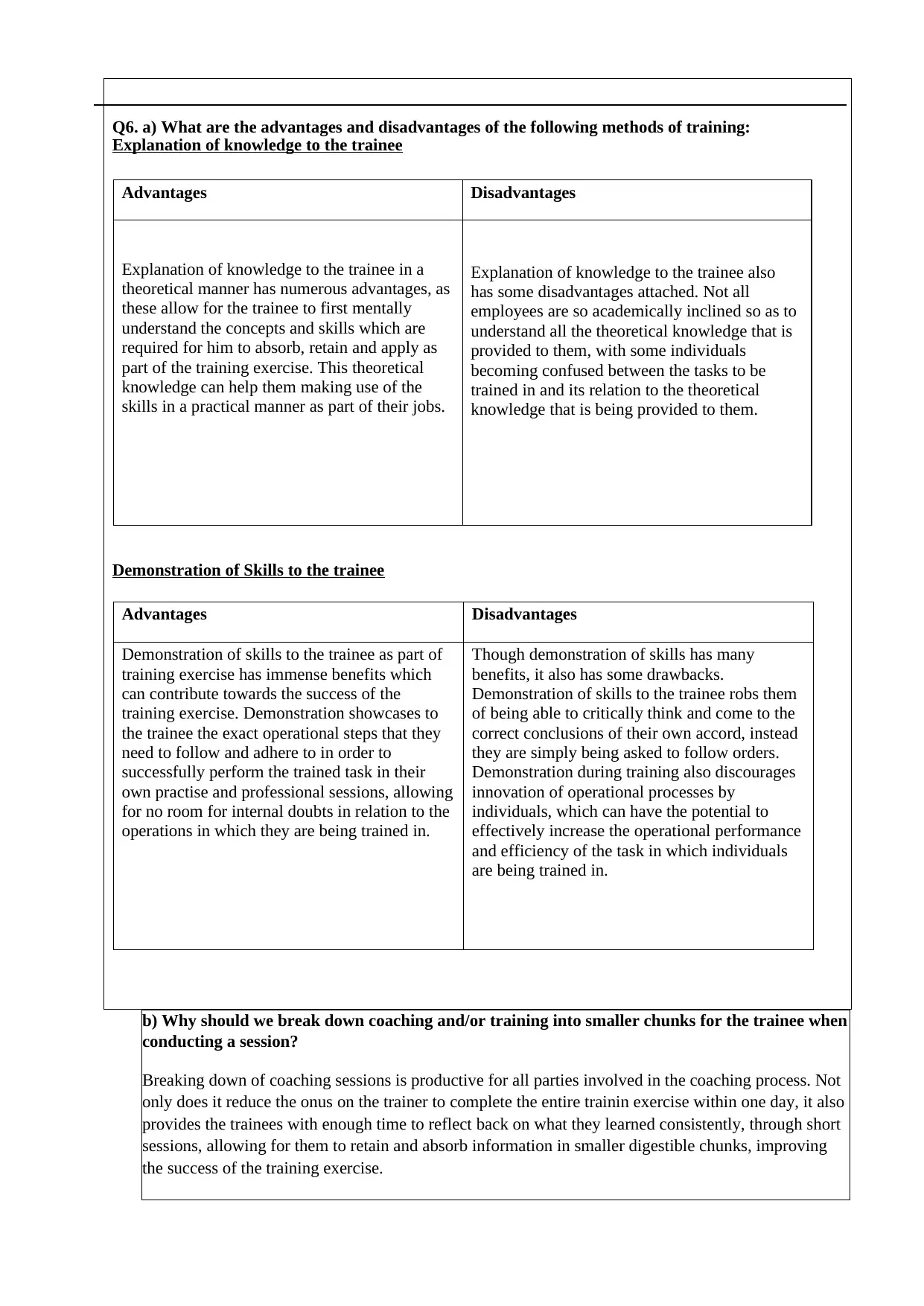
Q6. a) What are the advantages and disadvantages of the following methods of training:
Explanation of knowledge to the trainee
Advantages Disadvantages
Explanation of knowledge to the trainee in a
theoretical manner has numerous advantages, as
these allow for the trainee to first mentally
understand the concepts and skills which are
required for him to absorb, retain and apply as
part of the training exercise. This theoretical
knowledge can help them making use of the
skills in a practical manner as part of their jobs.
Explanation of knowledge to the trainee also
has some disadvantages attached. Not all
employees are so academically inclined so as to
understand all the theoretical knowledge that is
provided to them, with some individuals
becoming confused between the tasks to be
trained in and its relation to the theoretical
knowledge that is being provided to them.
Demonstration of Skills to the trainee
Advantages Disadvantages
Demonstration of skills to the trainee as part of
training exercise has immense benefits which
can contribute towards the success of the
training exercise. Demonstration showcases to
the trainee the exact operational steps that they
need to follow and adhere to in order to
successfully perform the trained task in their
own practise and professional sessions, allowing
for no room for internal doubts in relation to the
operations in which they are being trained in.
Though demonstration of skills has many
benefits, it also has some drawbacks.
Demonstration of skills to the trainee robs them
of being able to critically think and come to the
correct conclusions of their own accord, instead
they are simply being asked to follow orders.
Demonstration during training also discourages
innovation of operational processes by
individuals, which can have the potential to
effectively increase the operational performance
and efficiency of the task in which individuals
are being trained in.
b) Why should we break down coaching and/or training into smaller chunks for the trainee when
conducting a session?
Breaking down of coaching sessions is productive for all parties involved in the coaching process. Not
only does it reduce the onus on the trainer to complete the entire trainin exercise within one day, it also
provides the trainees with enough time to reflect back on what they learned consistently, through short
sessions, allowing for them to retain and absorb information in smaller digestible chunks, improving
the success of the training exercise.
Explanation of knowledge to the trainee
Advantages Disadvantages
Explanation of knowledge to the trainee in a
theoretical manner has numerous advantages, as
these allow for the trainee to first mentally
understand the concepts and skills which are
required for him to absorb, retain and apply as
part of the training exercise. This theoretical
knowledge can help them making use of the
skills in a practical manner as part of their jobs.
Explanation of knowledge to the trainee also
has some disadvantages attached. Not all
employees are so academically inclined so as to
understand all the theoretical knowledge that is
provided to them, with some individuals
becoming confused between the tasks to be
trained in and its relation to the theoretical
knowledge that is being provided to them.
Demonstration of Skills to the trainee
Advantages Disadvantages
Demonstration of skills to the trainee as part of
training exercise has immense benefits which
can contribute towards the success of the
training exercise. Demonstration showcases to
the trainee the exact operational steps that they
need to follow and adhere to in order to
successfully perform the trained task in their
own practise and professional sessions, allowing
for no room for internal doubts in relation to the
operations in which they are being trained in.
Though demonstration of skills has many
benefits, it also has some drawbacks.
Demonstration of skills to the trainee robs them
of being able to critically think and come to the
correct conclusions of their own accord, instead
they are simply being asked to follow orders.
Demonstration during training also discourages
innovation of operational processes by
individuals, which can have the potential to
effectively increase the operational performance
and efficiency of the task in which individuals
are being trained in.
b) Why should we break down coaching and/or training into smaller chunks for the trainee when
conducting a session?
Breaking down of coaching sessions is productive for all parties involved in the coaching process. Not
only does it reduce the onus on the trainer to complete the entire trainin exercise within one day, it also
provides the trainees with enough time to reflect back on what they learned consistently, through short
sessions, allowing for them to retain and absorb information in smaller digestible chunks, improving
the success of the training exercise.
⊘ This is a preview!⊘
Do you want full access?
Subscribe today to unlock all pages.

Trusted by 1+ million students worldwide
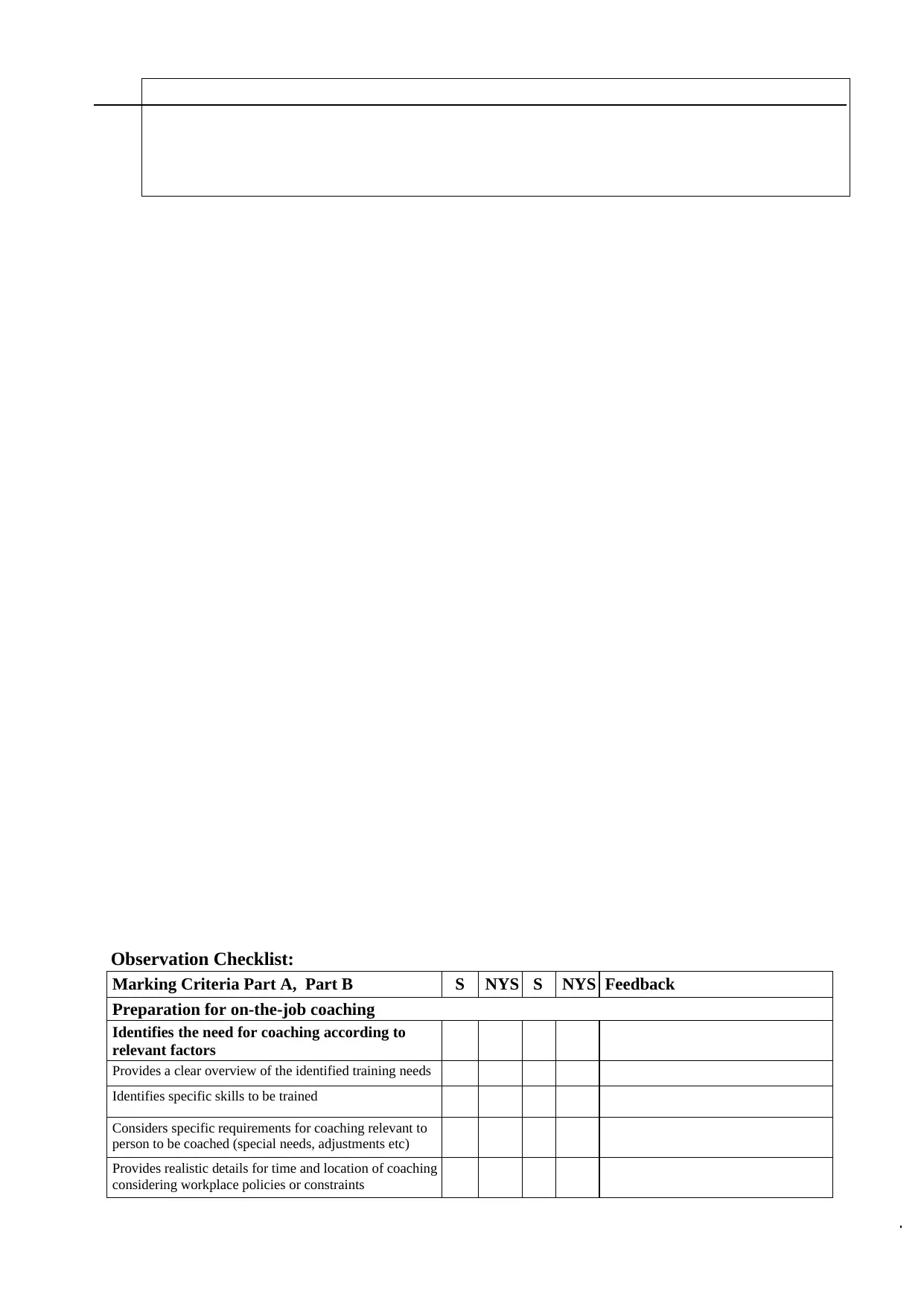
Observation Checklist:
Marking Criteria Part A, Part B S NYS S NYS Feedback
Preparation for on-the-job coaching
Identifies the need for coaching according to
relevant factors
Provides a clear overview of the identified training needs
Identifies specific skills to be trained
Considers specific requirements for coaching relevant to
person to be coached (special needs, adjustments etc)
Provides realistic details for time and location of coaching
considering workplace policies or constraints
Marking Criteria Part A, Part B S NYS S NYS Feedback
Preparation for on-the-job coaching
Identifies the need for coaching according to
relevant factors
Provides a clear overview of the identified training needs
Identifies specific skills to be trained
Considers specific requirements for coaching relevant to
person to be coached (special needs, adjustments etc)
Provides realistic details for time and location of coaching
considering workplace policies or constraints
Paraphrase This Document
Need a fresh take? Get an instant paraphrase of this document with our AI Paraphraser
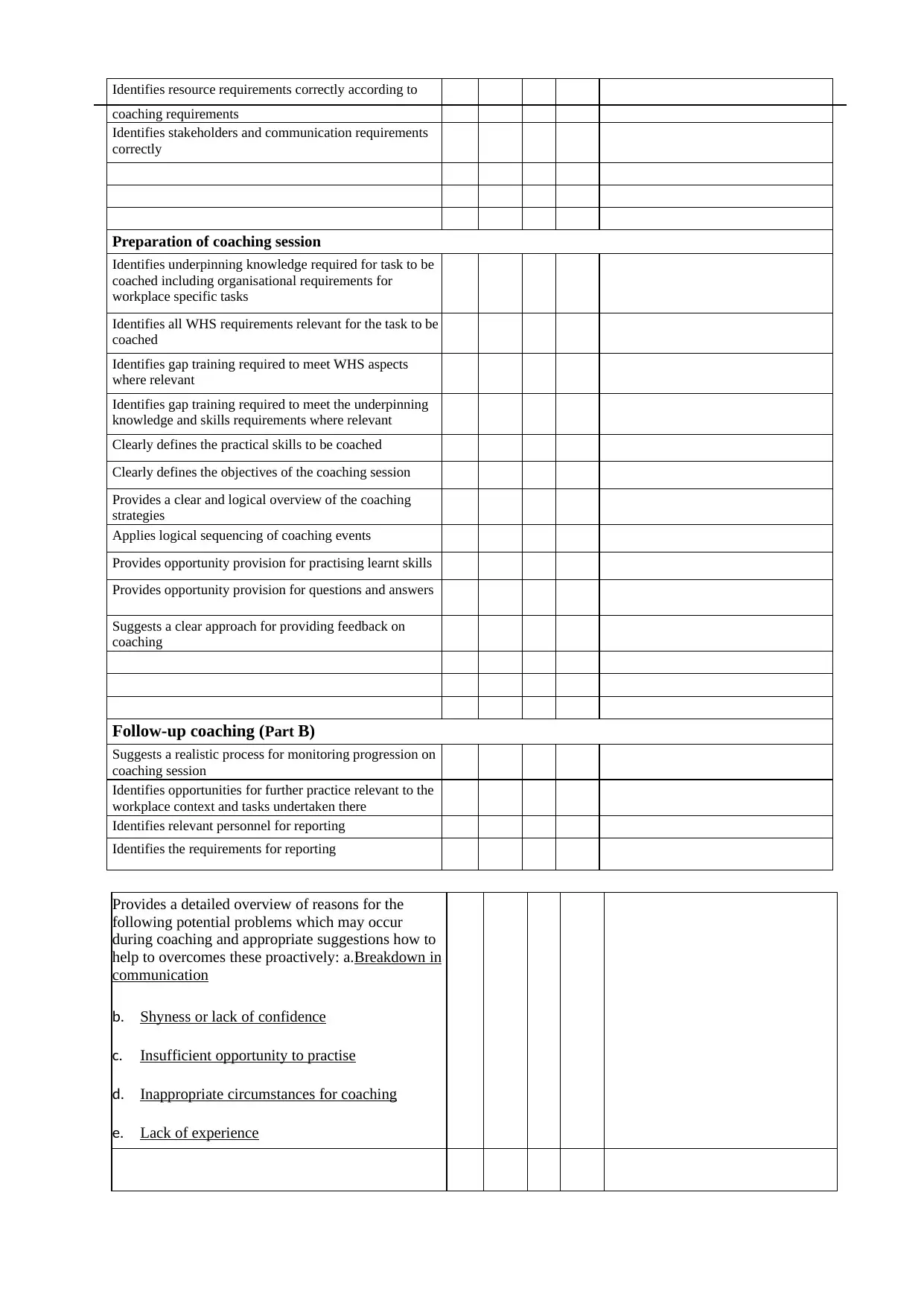
Identifies resource requirements correctly according to
coaching requirements
Identifies stakeholders and communication requirements
correctly
Preparation of coaching session
Identifies underpinning knowledge required for task to be
coached including organisational requirements for
workplace specific tasks
Identifies all WHS requirements relevant for the task to be
coached
Identifies gap training required to meet WHS aspects
where relevant
Identifies gap training required to meet the underpinning
knowledge and skills requirements where relevant
Clearly defines the practical skills to be coached
Clearly defines the objectives of the coaching session
Provides a clear and logical overview of the coaching
strategies
Applies logical sequencing of coaching events
Provides opportunity provision for practising learnt skills
Provides opportunity provision for questions and answers
Suggests a clear approach for providing feedback on
coaching
Follow-up coaching (Part B)
Suggests a realistic process for monitoring progression on
coaching session
Identifies opportunities for further practice relevant to the
workplace context and tasks undertaken there
Identifies relevant personnel for reporting
Identifies the requirements for reporting
Provides a detailed overview of reasons for the
following potential problems which may occur
during coaching and appropriate suggestions how to
help to overcomes these proactively: a.Breakdown in
communication
b. Shyness or lack of confidence
c. Insufficient opportunity to practise
d. Inappropriate circumstances for coaching
e. Lack of experience
coaching requirements
Identifies stakeholders and communication requirements
correctly
Preparation of coaching session
Identifies underpinning knowledge required for task to be
coached including organisational requirements for
workplace specific tasks
Identifies all WHS requirements relevant for the task to be
coached
Identifies gap training required to meet WHS aspects
where relevant
Identifies gap training required to meet the underpinning
knowledge and skills requirements where relevant
Clearly defines the practical skills to be coached
Clearly defines the objectives of the coaching session
Provides a clear and logical overview of the coaching
strategies
Applies logical sequencing of coaching events
Provides opportunity provision for practising learnt skills
Provides opportunity provision for questions and answers
Suggests a clear approach for providing feedback on
coaching
Follow-up coaching (Part B)
Suggests a realistic process for monitoring progression on
coaching session
Identifies opportunities for further practice relevant to the
workplace context and tasks undertaken there
Identifies relevant personnel for reporting
Identifies the requirements for reporting
Provides a detailed overview of reasons for the
following potential problems which may occur
during coaching and appropriate suggestions how to
help to overcomes these proactively: a.Breakdown in
communication
b. Shyness or lack of confidence
c. Insufficient opportunity to practise
d. Inappropriate circumstances for coaching
e. Lack of experience
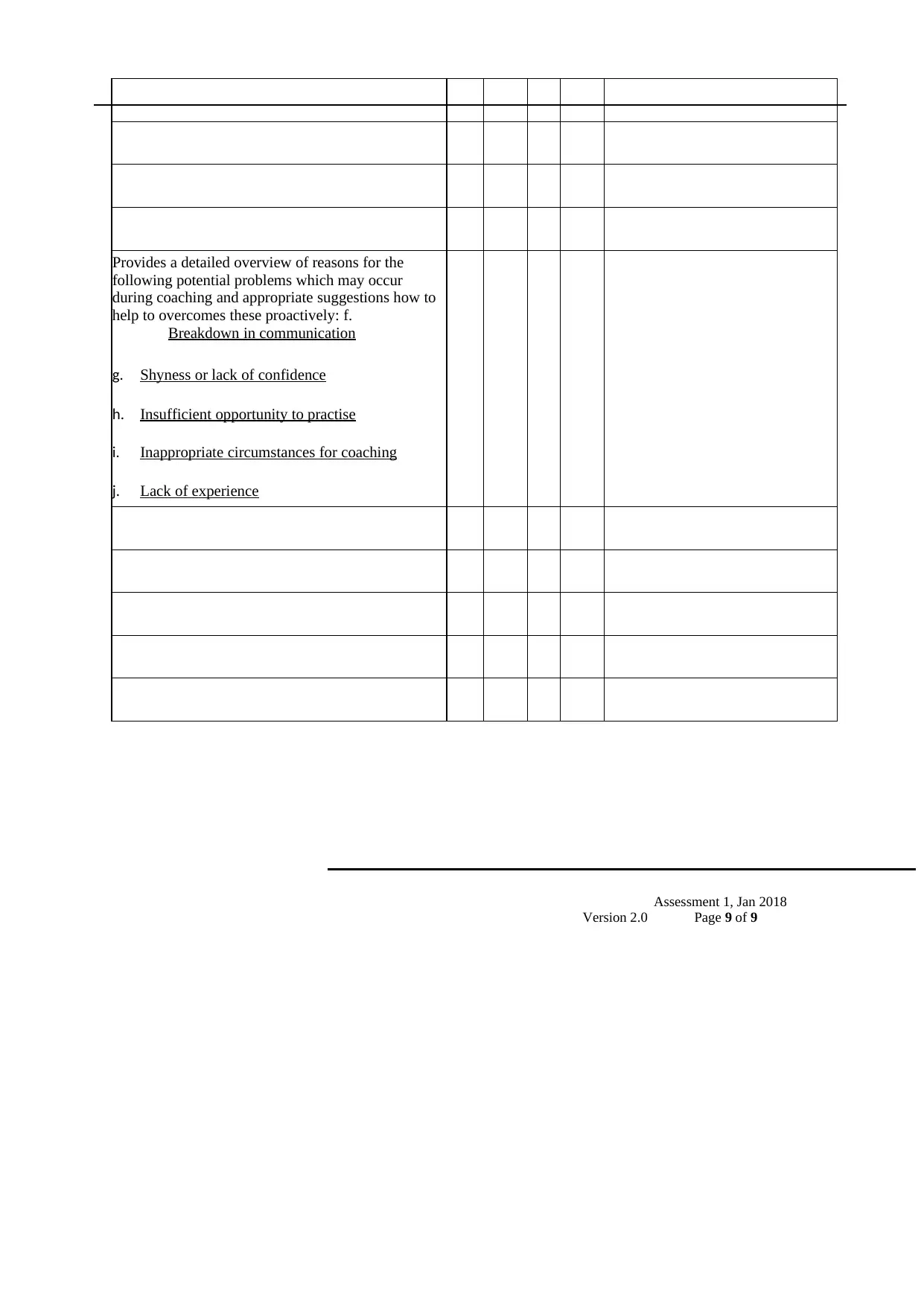
Provides a detailed overview of reasons for the
following potential problems which may occur
during coaching and appropriate suggestions how to
help to overcomes these proactively: f.
Breakdown in communication
g. Shyness or lack of confidence
h. Insufficient opportunity to practise
i. Inappropriate circumstances for coaching
j. Lack of experience
Assessment 1, Jan 2018
Version 2.0 Page 9 of 9
following potential problems which may occur
during coaching and appropriate suggestions how to
help to overcomes these proactively: f.
Breakdown in communication
g. Shyness or lack of confidence
h. Insufficient opportunity to practise
i. Inappropriate circumstances for coaching
j. Lack of experience
Assessment 1, Jan 2018
Version 2.0 Page 9 of 9
⊘ This is a preview!⊘
Do you want full access?
Subscribe today to unlock all pages.

Trusted by 1+ million students worldwide
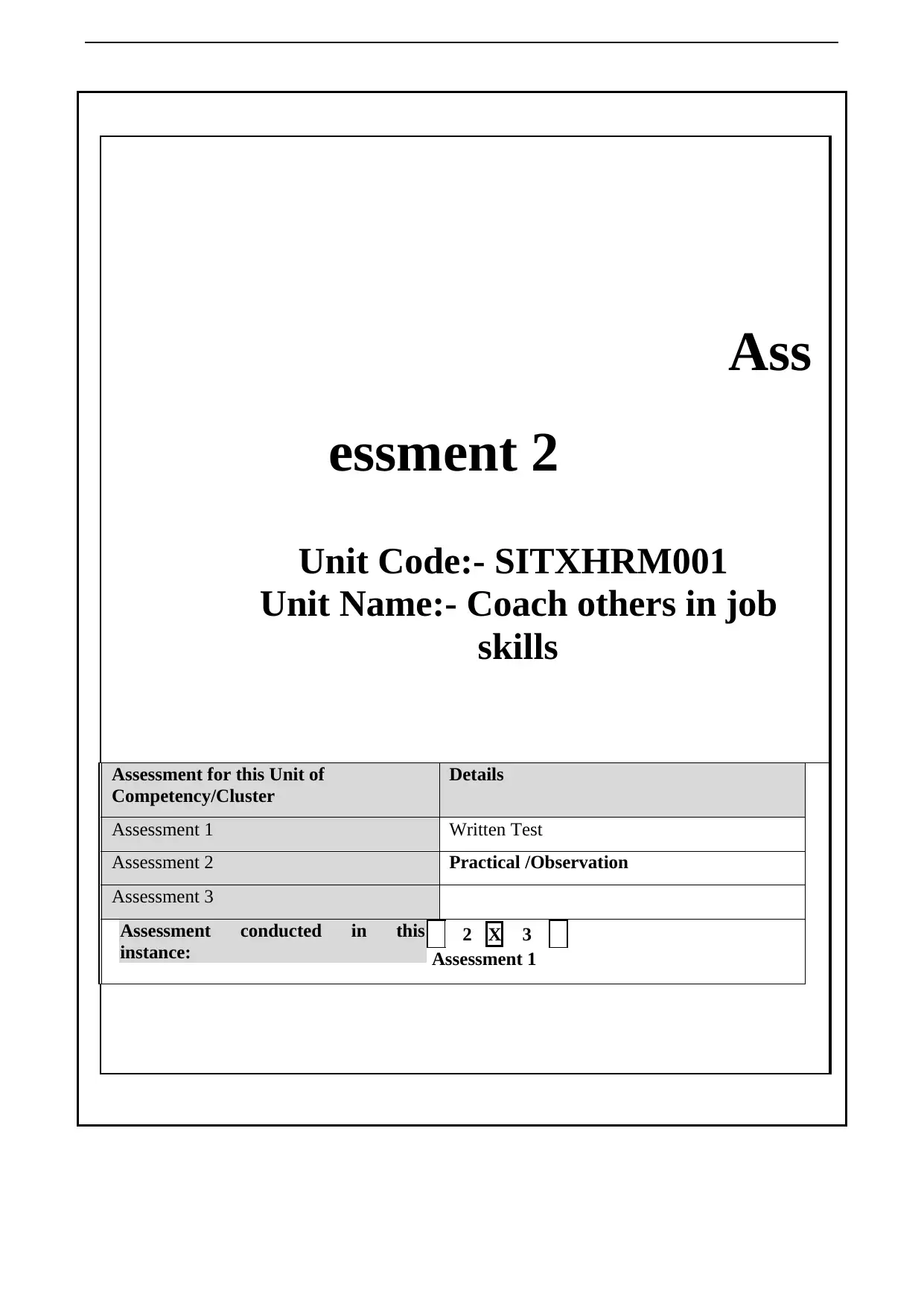
Ass
essment 2
Unit Code:- SITXHRM001
Unit Name:- Coach others in job
skills
Assessment for this Unit of
Competency/Cluster
Details
Assessment 1 Written Test
Assessment 2 Practical /Observation
Assessment 3
Assessment conducted in this
instance: 2 X 3
Assessment 1
essment 2
Unit Code:- SITXHRM001
Unit Name:- Coach others in job
skills
Assessment for this Unit of
Competency/Cluster
Details
Assessment 1 Written Test
Assessment 2 Practical /Observation
Assessment 3
Assessment conducted in this
instance: 2 X 3
Assessment 1
Paraphrase This Document
Need a fresh take? Get an instant paraphrase of this document with our AI Paraphraser
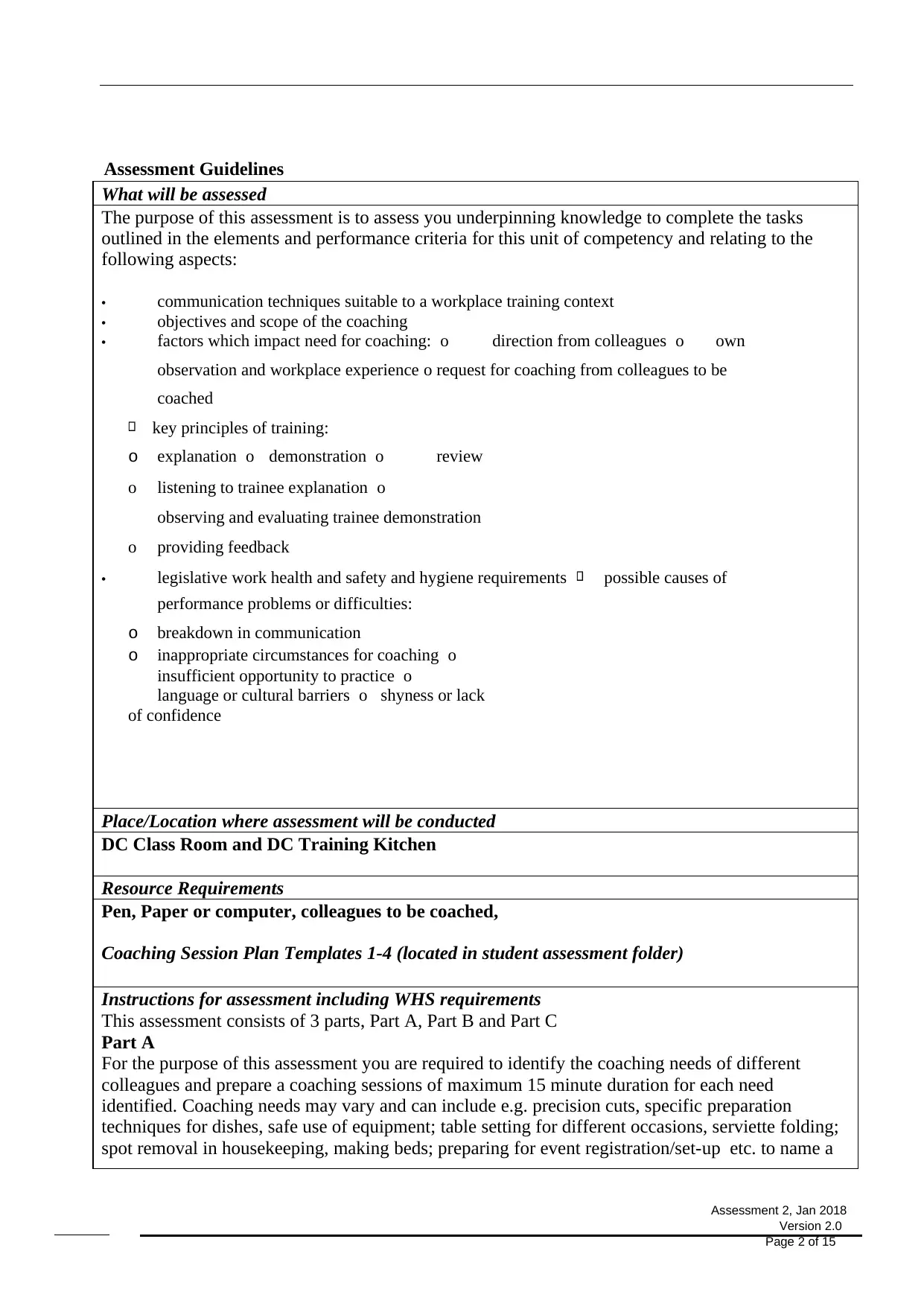
Assessment Guidelines
What will be assessed
The purpose of this assessment is to assess you underpinning knowledge to complete the tasks
outlined in the elements and performance criteria for this unit of competency and relating to the
following aspects:
• communication techniques suitable to a workplace training context
• objectives and scope of the coaching
• factors which impact need for coaching: o direction from colleagues o own
observation and workplace experience o request for coaching from colleagues to be
coached
key principles of training:
o explanation o demonstration o review
o listening to trainee explanation o
observing and evaluating trainee demonstration
o providing feedback
• legislative work health and safety and hygiene requirements possible causes of
performance problems or difficulties:
o breakdown in communication
o inappropriate circumstances for coaching o
insufficient opportunity to practice o
language or cultural barriers o shyness or lack
of confidence
Place/Location where assessment will be conducted
DC Class Room and DC Training Kitchen
Resource Requirements
Pen, Paper or computer, colleagues to be coached,
Coaching Session Plan Templates 1-4 (located in student assessment folder)
Instructions for assessment including WHS requirements
This assessment consists of 3 parts, Part A, Part B and Part C
Part A
For the purpose of this assessment you are required to identify the coaching needs of different
colleagues and prepare a coaching sessions of maximum 15 minute duration for each need
identified. Coaching needs may vary and can include e.g. precision cuts, specific preparation
techniques for dishes, safe use of equipment; table setting for different occasions, serviette folding;
spot removal in housekeeping, making beds; preparing for event registration/set-up etc. to name a
Assessment 2, Jan 2018
Version 2.0
Page 2 of 15
What will be assessed
The purpose of this assessment is to assess you underpinning knowledge to complete the tasks
outlined in the elements and performance criteria for this unit of competency and relating to the
following aspects:
• communication techniques suitable to a workplace training context
• objectives and scope of the coaching
• factors which impact need for coaching: o direction from colleagues o own
observation and workplace experience o request for coaching from colleagues to be
coached
key principles of training:
o explanation o demonstration o review
o listening to trainee explanation o
observing and evaluating trainee demonstration
o providing feedback
• legislative work health and safety and hygiene requirements possible causes of
performance problems or difficulties:
o breakdown in communication
o inappropriate circumstances for coaching o
insufficient opportunity to practice o
language or cultural barriers o shyness or lack
of confidence
Place/Location where assessment will be conducted
DC Class Room and DC Training Kitchen
Resource Requirements
Pen, Paper or computer, colleagues to be coached,
Coaching Session Plan Templates 1-4 (located in student assessment folder)
Instructions for assessment including WHS requirements
This assessment consists of 3 parts, Part A, Part B and Part C
Part A
For the purpose of this assessment you are required to identify the coaching needs of different
colleagues and prepare a coaching sessions of maximum 15 minute duration for each need
identified. Coaching needs may vary and can include e.g. precision cuts, specific preparation
techniques for dishes, safe use of equipment; table setting for different occasions, serviette folding;
spot removal in housekeeping, making beds; preparing for event registration/set-up etc. to name a
Assessment 2, Jan 2018
Version 2.0
Page 2 of 15
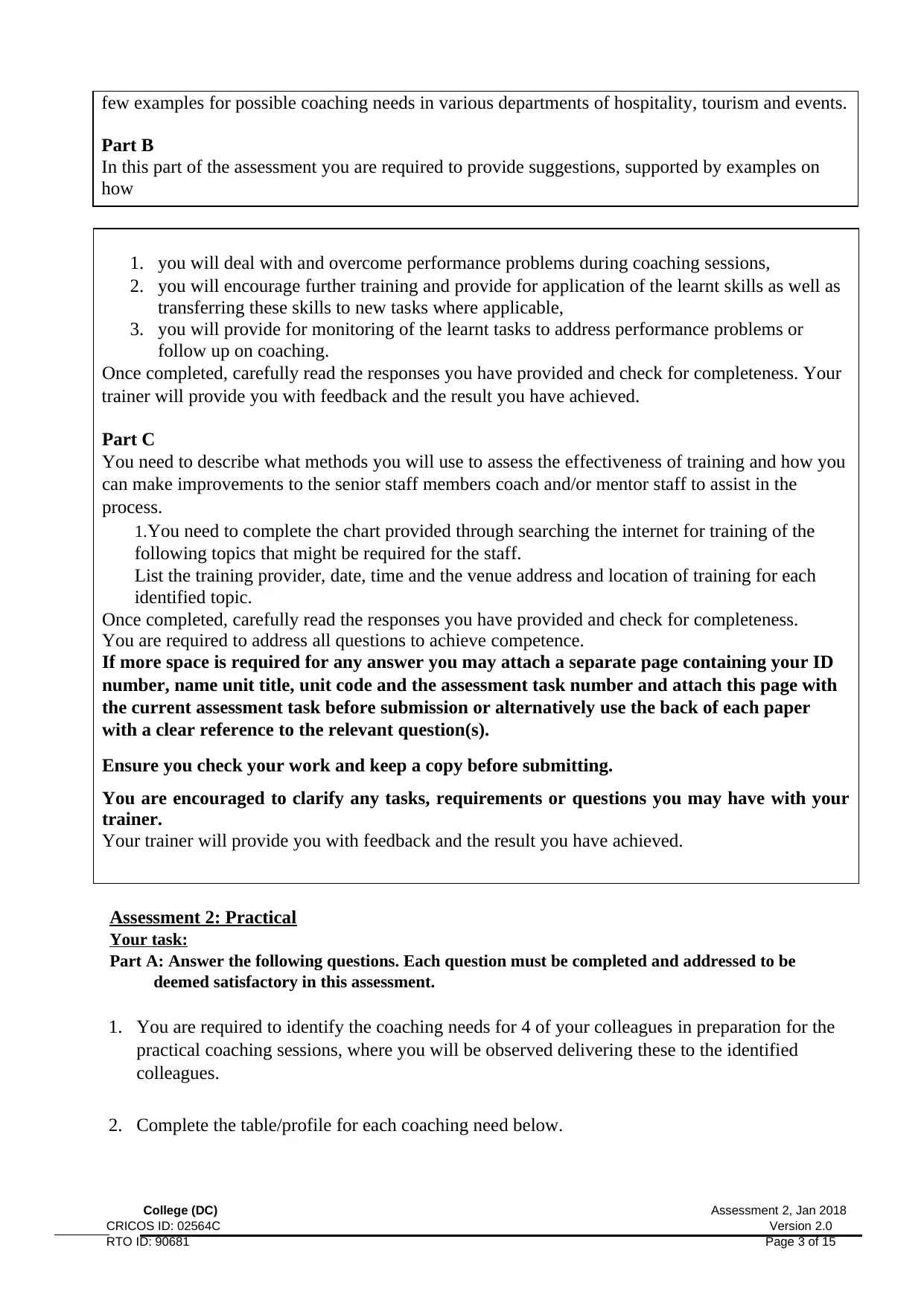
few examples for possible coaching needs in various departments of hospitality, tourism and events.
Part B
In this part of the assessment you are required to provide suggestions, supported by examples on
how
1. you will deal with and overcome performance problems during coaching sessions,
2. you will encourage further training and provide for application of the learnt skills as well as
transferring these skills to new tasks where applicable,
3. you will provide for monitoring of the learnt tasks to address performance problems or
follow up on coaching.
Once completed, carefully read the responses you have provided and check for completeness. Your
trainer will provide you with feedback and the result you have achieved.
Part C
You need to describe what methods you will use to assess the effectiveness of training and how you
can make improvements to the senior staff members coach and/or mentor staff to assist in the
process.
1.You need to complete the chart provided through searching the internet for training of the
following topics that might be required for the staff.
List the training provider, date, time and the venue address and location of training for each
identified topic.
Once completed, carefully read the responses you have provided and check for completeness.
You are required to address all questions to achieve competence.
If more space is required for any answer you may attach a separate page containing your ID
number, name unit title, unit code and the assessment task number and attach this page with
the current assessment task before submission or alternatively use the back of each paper
with a clear reference to the relevant question(s).
Ensure you check your work and keep a copy before submitting.
You are encouraged to clarify any tasks, requirements or questions you may have with your
trainer.
Your trainer will provide you with feedback and the result you have achieved.
Assessment 2: Practical
Your task:
Part A: Answer the following questions. Each question must be completed and addressed to be
deemed satisfactory in this assessment.
1. You are required to identify the coaching needs for 4 of your colleagues in preparation for the
practical coaching sessions, where you will be observed delivering these to the identified
colleagues.
2. Complete the table/profile for each coaching need below.
College (DC) Assessment 2, Jan 2018
CRICOS ID: 02564C Version 2.0
RTO ID: 90681 Page 3 of 15
Part B
In this part of the assessment you are required to provide suggestions, supported by examples on
how
1. you will deal with and overcome performance problems during coaching sessions,
2. you will encourage further training and provide for application of the learnt skills as well as
transferring these skills to new tasks where applicable,
3. you will provide for monitoring of the learnt tasks to address performance problems or
follow up on coaching.
Once completed, carefully read the responses you have provided and check for completeness. Your
trainer will provide you with feedback and the result you have achieved.
Part C
You need to describe what methods you will use to assess the effectiveness of training and how you
can make improvements to the senior staff members coach and/or mentor staff to assist in the
process.
1.You need to complete the chart provided through searching the internet for training of the
following topics that might be required for the staff.
List the training provider, date, time and the venue address and location of training for each
identified topic.
Once completed, carefully read the responses you have provided and check for completeness.
You are required to address all questions to achieve competence.
If more space is required for any answer you may attach a separate page containing your ID
number, name unit title, unit code and the assessment task number and attach this page with
the current assessment task before submission or alternatively use the back of each paper
with a clear reference to the relevant question(s).
Ensure you check your work and keep a copy before submitting.
You are encouraged to clarify any tasks, requirements or questions you may have with your
trainer.
Your trainer will provide you with feedback and the result you have achieved.
Assessment 2: Practical
Your task:
Part A: Answer the following questions. Each question must be completed and addressed to be
deemed satisfactory in this assessment.
1. You are required to identify the coaching needs for 4 of your colleagues in preparation for the
practical coaching sessions, where you will be observed delivering these to the identified
colleagues.
2. Complete the table/profile for each coaching need below.
College (DC) Assessment 2, Jan 2018
CRICOS ID: 02564C Version 2.0
RTO ID: 90681 Page 3 of 15
⊘ This is a preview!⊘
Do you want full access?
Subscribe today to unlock all pages.

Trusted by 1+ million students worldwide
1 out of 30
Related Documents
Your All-in-One AI-Powered Toolkit for Academic Success.
+13062052269
info@desklib.com
Available 24*7 on WhatsApp / Email
![[object Object]](/_next/static/media/star-bottom.7253800d.svg)
Unlock your academic potential
Copyright © 2020–2025 A2Z Services. All Rights Reserved. Developed and managed by ZUCOL.





